Your Blog Was Rejected From AdSense: Now What?
Published by James Parsons • Monetization • Posted July 5, 2017 ContentPowered.com
ContentPowered.com
AdSense is an easy, fast way to monetize a blog, though it’s certainly not very high paying unless you have a ton of traffic. However, in order to keep the ad network from descending into complete crap, Google filters the sites they allow to use AdSense. When you apply, they will scan your site looking for any possible violations of their terms of service. If you’re violating them, you will be rejected. Often times, Google is very bad at telling you just WHY they rejected you, so it can seem to be a hopeless situation.
Being rejected in an AdSense application is actually a better situation than slipping through by the skin of your teeth. If you slip through, Google will occasionally scan and audit your site to make sure you’re in compliance. If they then find you in violation of their ToS, you will be banned from the program. When you’re rejected, you can change up your site and try again. When you’re banned, you’re out of luck.
Step 1: Keep Calm and Carry On
A lot of bloggers feel dejected when they are rejected from an ad network like Google’s AdSense. Suddenly, their plans of monetizing their blog are no longer viable. You have to find an alternative, fix some issue you don’t know about, or just simply delay monetizing. If you were trying to quit your job and live off your blog – or worse, you were fired and are using this as a last-ditch effort – it can be devastating.
Thankfully, you can always apply again. You can fix whatever issue Google cares about, apply again, and hopefully be accepted the second time around. However, one thing you should NOT do is immediately reapply. If you apply a second time right away, without fixing anything, you’re just wasting time.
Don’t panic, don’t quit, but don’t try to jump the gun. Like many things in web marketing and web business, fixing your issues will take time.
Step 2: Figure Out Why You Were Rejected
The first thing you need to do when you’re rejected is figure out exactly why. Google will send you an email with something vague, like “insufficient content” or “content quality issues” and leave it up to you to figure out exactly what that means.
Here are the most common causes for rejection:
Your website is too new. I’m not sure if it’s actually written down anywhere, but Google AdSense actually only accepts sites that are at minimum six months old. If you just created a website, they will check to see when it came up in their index, when the site was put together, and how long it has been running. If your site is too young, you will be rejected on the grounds that they aren’t sure if you’re really into this whole “blogging” thing. Plus, it’s a way for Google to filter out the people who make shitty sites full of stolen content designed to rank and make money for a month or two then disappear.
Your website doesn’t have enough content. Related to being too young, a site without much content doesn’t have much in the way of keywords, targets, or traffic for AdSense to run. If you have too little content, Google’s analysts can’t properly determine what your site is about.
This can actually be an issue in old, content-rich sites if that content is not in text form. Sites that make heavy use of images like infographics or photo galleries, and sites that use multimedia content like videos or Flash content, aren’t properly indexed and will show as having insufficient content.
The content on your website is poor quality. Google has been spearheading the gradual improvement of web content quality since 2011, and it has been a trend in SEO for years now. Your site needs high quality content or it won’t rank, it won’t get traffic, it won’t earn subscribers, and it won’t be accepted into AdSense.
In order to solve this problem, you need to create new, high quality content, but you also need to revamp or remove your old, bad content. You can make good use of old content, but you need to do it properly to avoid potential issues.
The content on your website violates the terms of service. There are a bunch of rules about the kind of content you can have on your site. If your site is focusing on a banned subject, unfortunately, you’re out of luck. Nothing short of a complete content revamp will help, and at that point you might as well make an entirely new site.
What kind of content is banned? Google does not allow AdSense on sites that include pornography, adult material, violence, hate speech, hacking guides, illegal drugs, alcohol sales, weapon sales, and basically anything that’s illegal.
The content on your website is violating a copyright. This includes using trademarks you don’t own, posting content you didn’t create, hosting content you don’t have the rights to distribute – like pirated music or movies – and other such issues. Don’t steal blog posts, don’t host pirated software, don’t sell counterfeit products, and don’t distribute stolen media.
Your site has malware or signs of being hacked. Google will scan your entire site when you apply for AdSense. They’ll look for malicious code, signs that you’re distributing malware, evidence that you’re used as a landing page for spam emails, and other such issues. Sometimes, hackers will even leave your site alone when they breach your hosting, and simply add pages you don’t notice to use for their own nefarious ends. In rare cases, it’s possible that you were hacked and don’t know it.
Clean up all signs of malicious content, either on purpose or unwitting, and you should be free to apply again. I also recommend taking some serious steps towards securing your web presence, to prevent it from happening again.
You don’t have enough traffic. In this case, I’m not just talking about traffic in general. You can have a ton of traffic and still be rejected from AdSense for not having enough traffic. What you need is sufficient organic traffic. If you don’t have enough natural incoming traffic, Google doesn’t expect to be able to make money by serving you ads, so they reject you. Paid traffic is also sometimes unsafe to use with AdSense, either because of the quality of the traffic or because of how it can exploit ad code.
This is one of the hardest problems to solve, because it can take quite a while to build up an organic following. You’ll have to embark on a serious campaign of white hat SEO, which can take months or years to bear fruit.
Your traffic is low quality. Similarly, if Google analyzes your traffic and finds that you don’t meet their quality standards, you’ll eat a rejection. For example, if you’re a small business in Kansas looking to monetize your blog, but 95% of your traffic is coming from India, Google can be pretty sure that those people aren’t interested in your page, they’re coming for some other reason. Rather than show ads to people who aren’t going to click or convert, they simply reject you.
You don’t have a contact, privacy policy or terms of service page. This is one of the simplest issues you can solve. Google wants you to have some legally-enforceable language on your site that says who you are and how to contact you, gives users an assurance of their privacy while browsing your site, and provides expectations on how users should act and how you enforce violations. It’s pretty easy to find a usable terms of service online, your privacy policy doesn’t need to be detailed – these are the minimum standards – and a contact page is trivial to throw online.
Your site design is terrible. Anything that violates common sense, usability, or crawling ease of use can get you rejected. A site that largely scrolls horizontally can count. Sites that look coded in tables and iframes circa 1996 count. Sites that have broken scripts, pop-ups or pop-unders, and other kinds of disruptive code all count. The harder it is for users to browse your site, the worse off you’ll be. Thankfully, it’s pretty easy to set up a site using WordPress and a good theme that there’s no excuse for this today. If you’re rejected for a bad site design, fire your designer and hire a high schooler who knows how to Google, because they’ll do better.
You don’t actually own the site. This is a rare one, but if you’re trying to monetize a site and you apply, you better make sure that the ownership information for the domain and the web hosting match the information you’re using for AdSense.
I’ve seen people try to get in using their friends’ site, and it doesn’t work. I’ve seen people try to get in using a random site with a name similar to theirs. I’ve seen people who were authorized representatives use their own information instead of company information and get rejected. Generally, you can work with Google and get approval if you can prove you actually own the site or are authorized to represent it. If you don’t, though, don’t bother trying again. Make your own site first.
You’re under the age of 18. Google, and actually most web services, require that you be of legal age to actually use the services. 18 is a pretty arbitrary number throughout the world, but it’s there, so you need to be older than 18 or get someone who is to fill out their information instead. That, or just lie about it. It’s not like Google asks for your birth certificate.
You’re not using your own domain. This is one that gets a lot of people these days, since it’s a change from the old ways. Today, you should be using your own domain name, like www.example.com, rather than a subdomain. Sites like example.wordpress.com or example.blogspot.com are going to find it very difficult to successfully apply for AdSense. Primarily, this was due to abuse of the free site hosting.
Generally, if you want to get a site on free hosting like that approved for AdSense, you will need to buy a domain to use. Both Blogspot and WordPress allow you to use a custom domain, and most domain names will only cost you something like $10 a year, so it’s not a large expense.
You’re using ads from other ad networks. AdSense doesn’t want to compete with other ads. You can use other ads on your site prior to enrolling in AdSense, and if you remove AdSense you can use other ads again, but you can’t use both AdSense and another ad network at the same time. Unfortunately, this means that when you apply to AdSense, you need to remove the other ad network from the site.
This primarily applies to display ads, however. Affiliate links are fine to use in conjunction with AdSense ads, though you do have to be aware of ad density rules. If you have too many ads on a page, you’ll find yourself experiencing SEO penalties and probably usability issues.
You have links from or links to bad sites. Bad links indicate that you’re not organically where you are. If you’re linking to or getting links from spam sites, it’s going to hurt your SEO and it’s going to jeopardize your AdSense enrollment. Use a tool like Majestic to audit your backlinks and the links on your site, get rid of the bad ones, and disavow the incoming links you can’t get removed.
Your content is in an unsupported language. Google actually only supports about 36 languages for AdSense sites. If your content is primarily in a language not on this list, you won’t be eligible unless they add your language to the list eventually.
You have been banned before. It’s against the terms of service to circumvent a ban by creating a new account. People can and have done it, but they have to be very careful about using different information, often including IP address, so it’s a giant hassle. If you’re caught using a second account, you can be banned again.
You have more than one AdSense account. Having more than one account can get you rejected or banned. If you’re rejected, you can close all but one account and then prove that you aren’t using more than one anymore. You should be able to get in afterwards.
Step 3: Fix and Repeat
Once you’ve identified the problem, take action to fix it. Most fixes are minimal, though a few might not be possible with your site. When you fix the issue, wait a few weeks or a couple of months, then apply again. Assuming you’re in total compliance, you should be able to get into the program and get to monetizing.
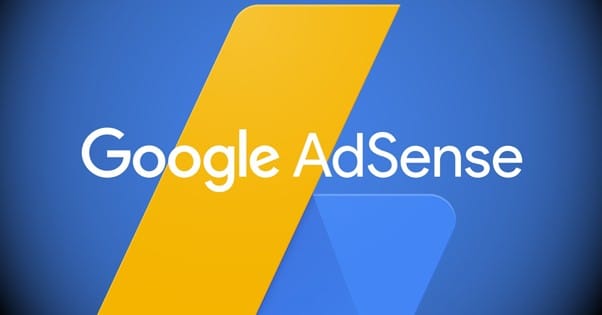
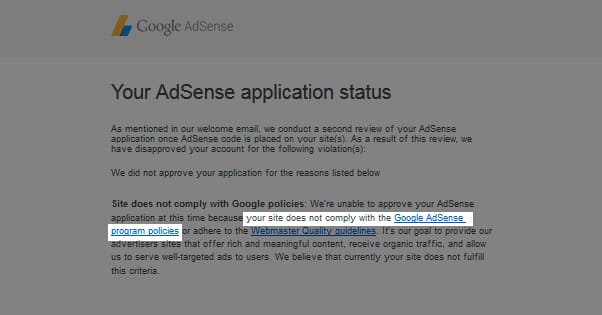
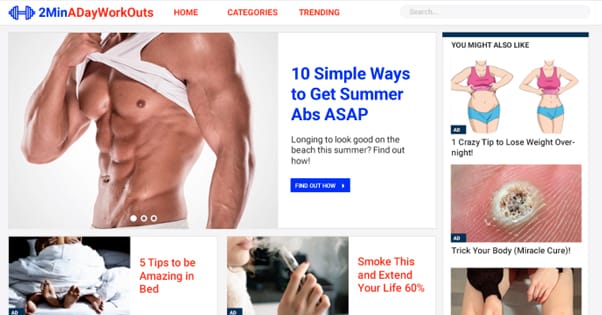
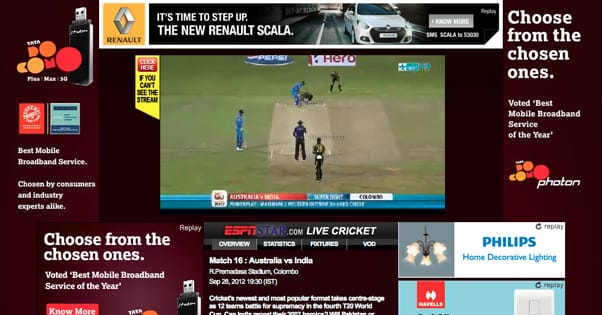

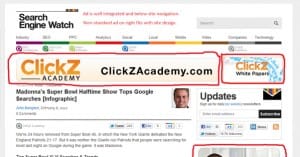
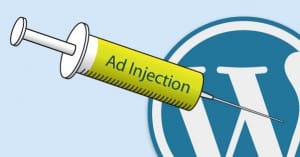


Great piece. Was just rejected.
Hey Chris, sorry to hear that. What are you learning towards as an alternative? Affiliate marketing tends to be better option than running ads for low traffic / newer websites.